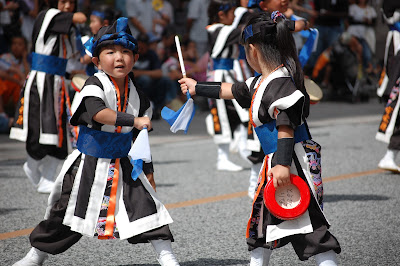Summertime in Okinawa is marked by festivals, food, and fireworks. Despite the rising temperatures, it seemed there was always another festival or “matsuri” to attend. In fact, Okinawans are known as festival people throughout Japan. My kind of place.
I learned early on that for a festival to be rated highly on the enjoyment scale, fireworks must be included. Fireworks always seem to be the focus of conversation when discussing a festival with an Okinawan friend. “You went to the festival? How were the fireworks?” It’s unthinkable to not stay for the fireworks. People would think something was wrong with you if you didn’t.
Another highlight of summer festivals are the Eisa performances. Eisa is a type of folk dance unique to Okinawa and truly represents the summer. It’s not unusual to walk through the neighborhood in the evening hearing people practicing the traditional instruments used in Eisa: the sanshin and the taiko drum. In fact, for a few solid weeks leading up to Obon, I fell asleep to the faint sounds of taiko drums banging away.
Eisa performers with taiko drums
Okinawan Sanshin made with snake skin
Obon is an important religious holiday celebrated throughout Japan with Buddhist roots. In brief, it is a three-day period when families remember and honor their dead relatives by welcoming their spirits back for a brief visit. Eisa dancers and music guide the deceased on their journey. Other traditions include special family meals, visits to family grave sites, offerings and prayers. While remember the dead may be somber occurrence, Obon also celebrates life and the overall atmosphere is relatively upbeat.
Little Eisa performers
On the last day of Obon when deceased spirits must depart, neighborhoods get together for all-night Eisa celebrations. Everyone in the neighborhood comes out to celebrate in true Okinawan style. After hearing the singing and drumming outside our house, Fred and I wandered outside to check out the Obon party, uncertain of whether or not the neighbors would approve of our American presence.
Outside our house
It didn’t take long before we felt welcomed with the international gesture of beer. Even though Fred already had a beer in hand, an older man shoved another chilled Orion into his hand cheerfully laughing “motto, motto!” (more, more!). We were also treated to chilled noodles and fresh watermelon from the neighbors as we enjoyed our beer and watched the older men stumble around with their bottles of awamori, the other local spirit.
Motto, motto!
The night continued with more dancing, singing, and of course, beer, while meandering throughout the neighborhood. Finally, the crowd ended at a cleared area that had been set up with a stage. The older and seemingly more important men of the neighborhood made their way onto the stage with their sanshins and bottles of awamori while the younger dancers and drummers circled the stage below.
Eventually, it turned into a free-for-all with all the neighbors dancing around the stage. I tried to catch on to the dance, but after a couple beers it became too much for me to concentrate on. So I watched and drank, instead.
Party in the neighborhood







No comments:
Post a Comment